Analysis of Resource-Based View: A Comprehensive Literature Review
VerifiedAdded on 2022/11/29
|9
|2059
|131
Literature Review
AI Summary
This literature review examines the Resource-Based View (RBV), a managerial framework used to determine how firms can achieve sustainable competitive advantages by exploiting their strategic resources. The review synthesizes several academic articles to explore the concept, its application in different business contexts, and its evolution since 1991. Key articles analyzed include those discussing the RBV's role in strategic management, its limitations, and its theoretical frameworks. The review covers various aspects, including tangible and intangible assets, human resource management, and the media industry. It explores how firms utilize resources to gain competitive edges, analyzes the impact of multiplatform distribution strategies, and investigates the application of RBV in different media markets. Furthermore, the review discusses the importance of integrating various business functions and adapting innovative approaches to leverage resources effectively, providing a comprehensive understanding of the RBV's implications and applications in the contemporary business environment.
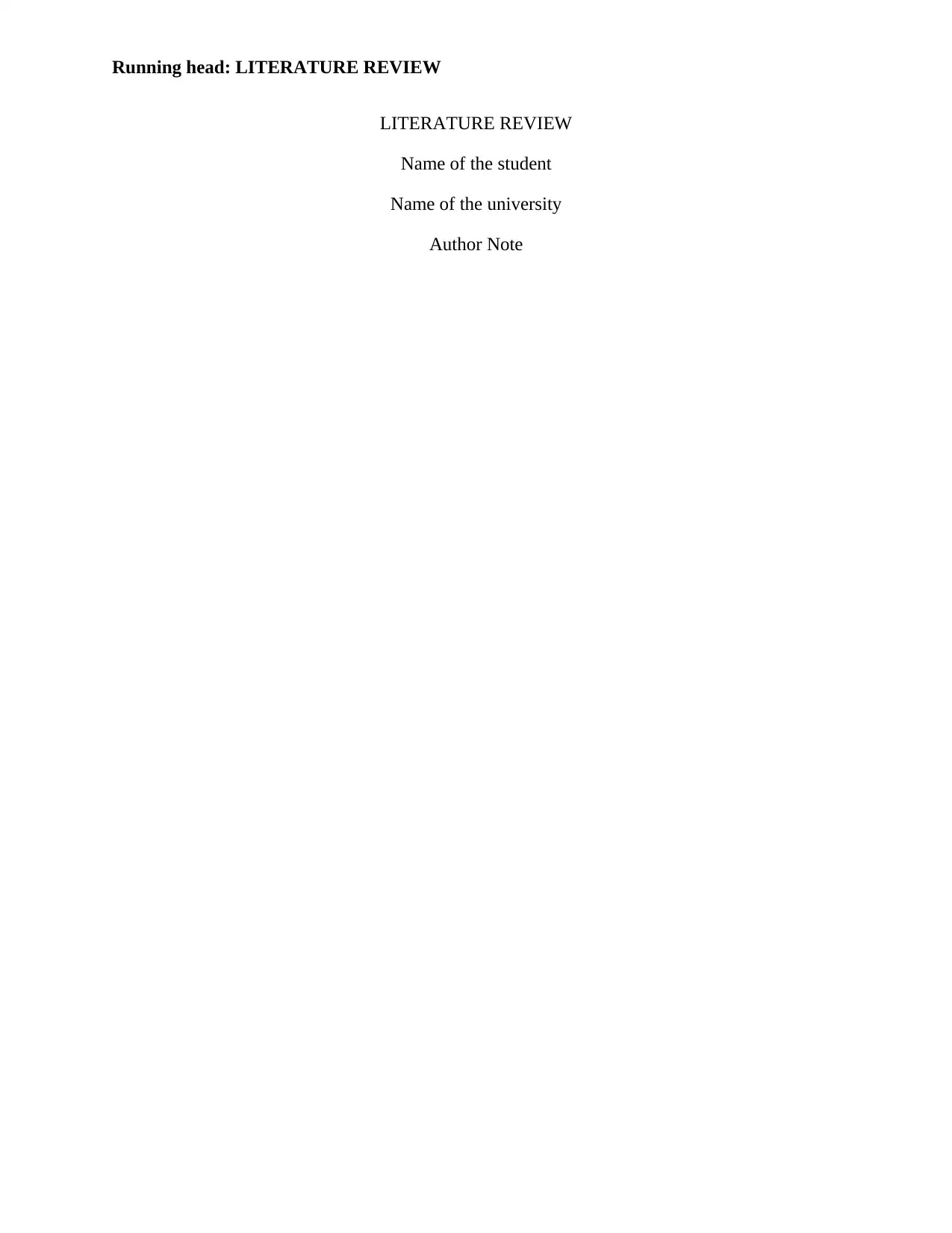
Running head: LITERATURE REVIEW
LITERATURE REVIEW
Name of the student
Name of the university
Author Note
LITERATURE REVIEW
Name of the student
Name of the university
Author Note
Paraphrase This Document
Need a fresh take? Get an instant paraphrase of this document with our AI Paraphraser
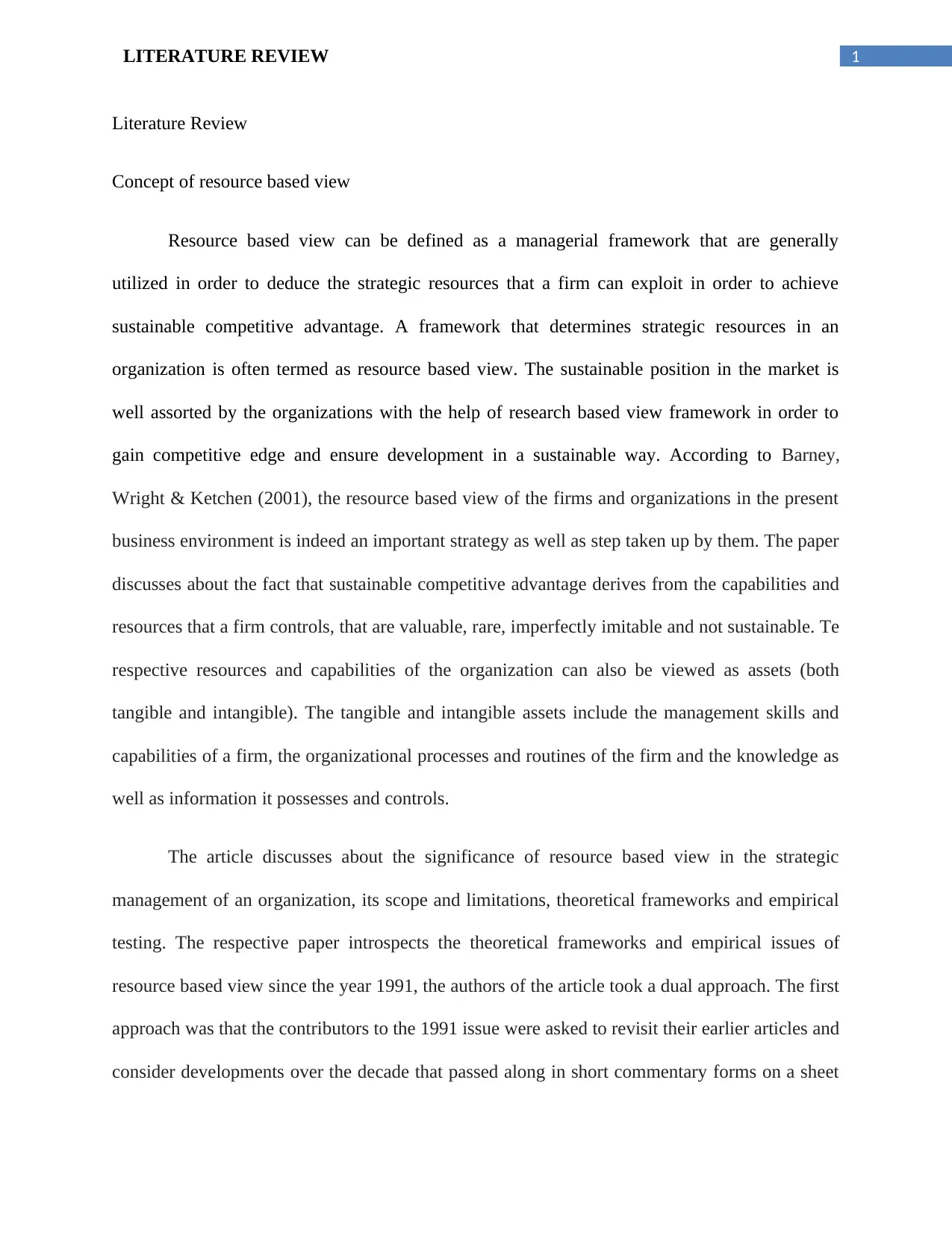
1LITERATURE REVIEW
Literature Review
Concept of resource based view
Resource based view can be defined as a managerial framework that are generally
utilized in order to deduce the strategic resources that a firm can exploit in order to achieve
sustainable competitive advantage. A framework that determines strategic resources in an
organization is often termed as resource based view. The sustainable position in the market is
well assorted by the organizations with the help of research based view framework in order to
gain competitive edge and ensure development in a sustainable way. According to Barney,
Wright & Ketchen (2001), the resource based view of the firms and organizations in the present
business environment is indeed an important strategy as well as step taken up by them. The paper
discusses about the fact that sustainable competitive advantage derives from the capabilities and
resources that a firm controls, that are valuable, rare, imperfectly imitable and not sustainable. Te
respective resources and capabilities of the organization can also be viewed as assets (both
tangible and intangible). The tangible and intangible assets include the management skills and
capabilities of a firm, the organizational processes and routines of the firm and the knowledge as
well as information it possesses and controls.
The article discusses about the significance of resource based view in the strategic
management of an organization, its scope and limitations, theoretical frameworks and empirical
testing. The respective paper introspects the theoretical frameworks and empirical issues of
resource based view since the year 1991, the authors of the article took a dual approach. The first
approach was that the contributors to the 1991 issue were asked to revisit their earlier articles and
consider developments over the decade that passed along in short commentary forms on a sheet
Literature Review
Concept of resource based view
Resource based view can be defined as a managerial framework that are generally
utilized in order to deduce the strategic resources that a firm can exploit in order to achieve
sustainable competitive advantage. A framework that determines strategic resources in an
organization is often termed as resource based view. The sustainable position in the market is
well assorted by the organizations with the help of research based view framework in order to
gain competitive edge and ensure development in a sustainable way. According to Barney,
Wright & Ketchen (2001), the resource based view of the firms and organizations in the present
business environment is indeed an important strategy as well as step taken up by them. The paper
discusses about the fact that sustainable competitive advantage derives from the capabilities and
resources that a firm controls, that are valuable, rare, imperfectly imitable and not sustainable. Te
respective resources and capabilities of the organization can also be viewed as assets (both
tangible and intangible). The tangible and intangible assets include the management skills and
capabilities of a firm, the organizational processes and routines of the firm and the knowledge as
well as information it possesses and controls.
The article discusses about the significance of resource based view in the strategic
management of an organization, its scope and limitations, theoretical frameworks and empirical
testing. The respective paper introspects the theoretical frameworks and empirical issues of
resource based view since the year 1991, the authors of the article took a dual approach. The first
approach was that the contributors to the 1991 issue were asked to revisit their earlier articles and
consider developments over the decade that passed along in short commentary forms on a sheet
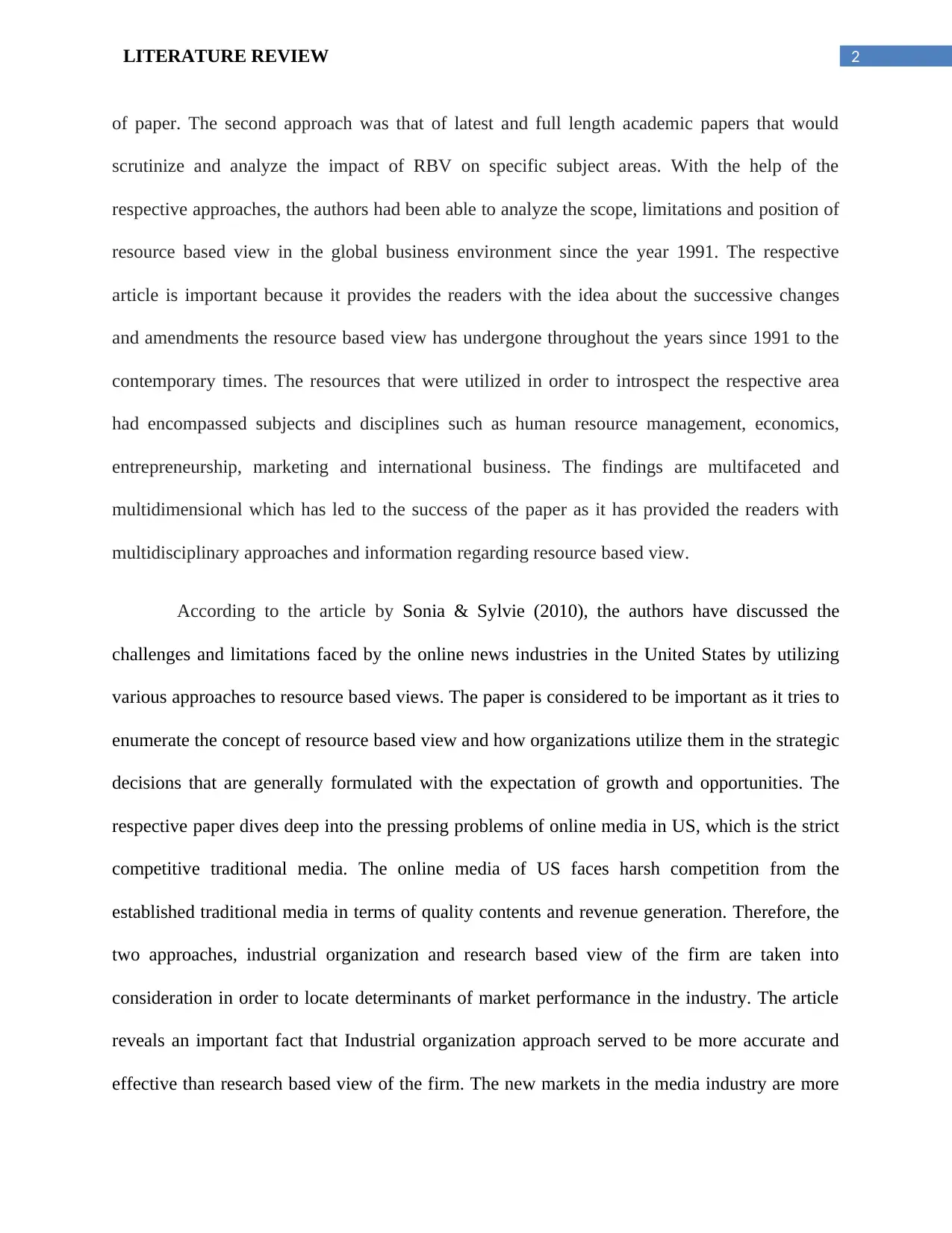
2LITERATURE REVIEW
of paper. The second approach was that of latest and full length academic papers that would
scrutinize and analyze the impact of RBV on specific subject areas. With the help of the
respective approaches, the authors had been able to analyze the scope, limitations and position of
resource based view in the global business environment since the year 1991. The respective
article is important because it provides the readers with the idea about the successive changes
and amendments the resource based view has undergone throughout the years since 1991 to the
contemporary times. The resources that were utilized in order to introspect the respective area
had encompassed subjects and disciplines such as human resource management, economics,
entrepreneurship, marketing and international business. The findings are multifaceted and
multidimensional which has led to the success of the paper as it has provided the readers with
multidisciplinary approaches and information regarding resource based view.
According to the article by Sonia & Sylvie (2010), the authors have discussed the
challenges and limitations faced by the online news industries in the United States by utilizing
various approaches to resource based views. The paper is considered to be important as it tries to
enumerate the concept of resource based view and how organizations utilize them in the strategic
decisions that are generally formulated with the expectation of growth and opportunities. The
respective paper dives deep into the pressing problems of online media in US, which is the strict
competitive traditional media. The online media of US faces harsh competition from the
established traditional media in terms of quality contents and revenue generation. Therefore, the
two approaches, industrial organization and research based view of the firm are taken into
consideration in order to locate determinants of market performance in the industry. The article
reveals an important fact that Industrial organization approach served to be more accurate and
effective than research based view of the firm. The new markets in the media industry are more
of paper. The second approach was that of latest and full length academic papers that would
scrutinize and analyze the impact of RBV on specific subject areas. With the help of the
respective approaches, the authors had been able to analyze the scope, limitations and position of
resource based view in the global business environment since the year 1991. The respective
article is important because it provides the readers with the idea about the successive changes
and amendments the resource based view has undergone throughout the years since 1991 to the
contemporary times. The resources that were utilized in order to introspect the respective area
had encompassed subjects and disciplines such as human resource management, economics,
entrepreneurship, marketing and international business. The findings are multifaceted and
multidimensional which has led to the success of the paper as it has provided the readers with
multidisciplinary approaches and information regarding resource based view.
According to the article by Sonia & Sylvie (2010), the authors have discussed the
challenges and limitations faced by the online news industries in the United States by utilizing
various approaches to resource based views. The paper is considered to be important as it tries to
enumerate the concept of resource based view and how organizations utilize them in the strategic
decisions that are generally formulated with the expectation of growth and opportunities. The
respective paper dives deep into the pressing problems of online media in US, which is the strict
competitive traditional media. The online media of US faces harsh competition from the
established traditional media in terms of quality contents and revenue generation. Therefore, the
two approaches, industrial organization and research based view of the firm are taken into
consideration in order to locate determinants of market performance in the industry. The article
reveals an important fact that Industrial organization approach served to be more accurate and
effective than research based view of the firm. The new markets in the media industry are more
⊘ This is a preview!⊘
Do you want full access?
Subscribe today to unlock all pages.

Trusted by 1+ million students worldwide
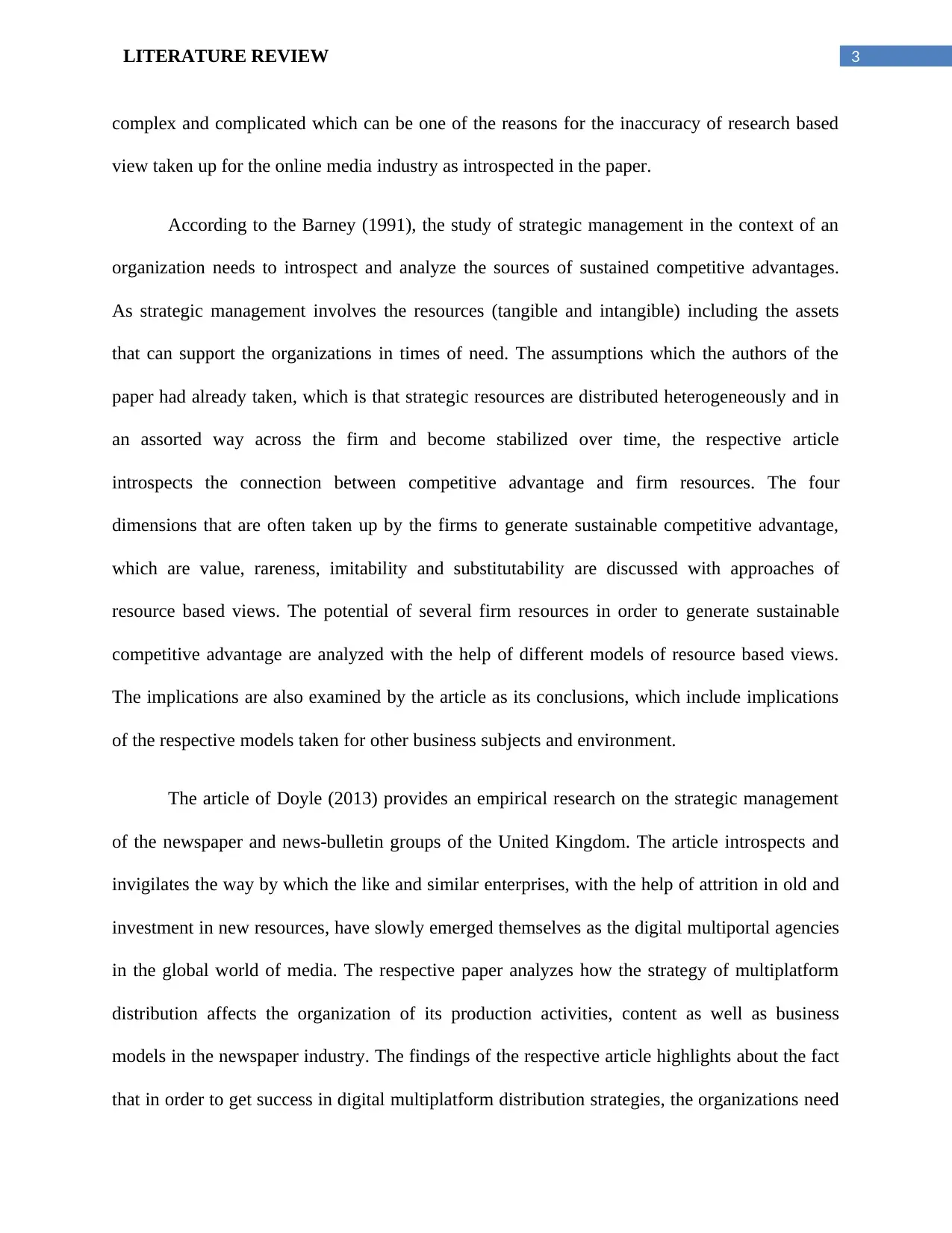
3LITERATURE REVIEW
complex and complicated which can be one of the reasons for the inaccuracy of research based
view taken up for the online media industry as introspected in the paper.
According to the Barney (1991), the study of strategic management in the context of an
organization needs to introspect and analyze the sources of sustained competitive advantages.
As strategic management involves the resources (tangible and intangible) including the assets
that can support the organizations in times of need. The assumptions which the authors of the
paper had already taken, which is that strategic resources are distributed heterogeneously and in
an assorted way across the firm and become stabilized over time, the respective article
introspects the connection between competitive advantage and firm resources. The four
dimensions that are often taken up by the firms to generate sustainable competitive advantage,
which are value, rareness, imitability and substitutability are discussed with approaches of
resource based views. The potential of several firm resources in order to generate sustainable
competitive advantage are analyzed with the help of different models of resource based views.
The implications are also examined by the article as its conclusions, which include implications
of the respective models taken for other business subjects and environment.
The article of Doyle (2013) provides an empirical research on the strategic management
of the newspaper and news-bulletin groups of the United Kingdom. The article introspects and
invigilates the way by which the like and similar enterprises, with the help of attrition in old and
investment in new resources, have slowly emerged themselves as the digital multiportal agencies
in the global world of media. The respective paper analyzes how the strategy of multiplatform
distribution affects the organization of its production activities, content as well as business
models in the newspaper industry. The findings of the respective article highlights about the fact
that in order to get success in digital multiplatform distribution strategies, the organizations need
complex and complicated which can be one of the reasons for the inaccuracy of research based
view taken up for the online media industry as introspected in the paper.
According to the Barney (1991), the study of strategic management in the context of an
organization needs to introspect and analyze the sources of sustained competitive advantages.
As strategic management involves the resources (tangible and intangible) including the assets
that can support the organizations in times of need. The assumptions which the authors of the
paper had already taken, which is that strategic resources are distributed heterogeneously and in
an assorted way across the firm and become stabilized over time, the respective article
introspects the connection between competitive advantage and firm resources. The four
dimensions that are often taken up by the firms to generate sustainable competitive advantage,
which are value, rareness, imitability and substitutability are discussed with approaches of
resource based views. The potential of several firm resources in order to generate sustainable
competitive advantage are analyzed with the help of different models of resource based views.
The implications are also examined by the article as its conclusions, which include implications
of the respective models taken for other business subjects and environment.
The article of Doyle (2013) provides an empirical research on the strategic management
of the newspaper and news-bulletin groups of the United Kingdom. The article introspects and
invigilates the way by which the like and similar enterprises, with the help of attrition in old and
investment in new resources, have slowly emerged themselves as the digital multiportal agencies
in the global world of media. The respective paper analyzes how the strategy of multiplatform
distribution affects the organization of its production activities, content as well as business
models in the newspaper industry. The findings of the respective article highlights about the fact
that in order to get success in digital multiplatform distribution strategies, the organizations need
Paraphrase This Document
Need a fresh take? Get an instant paraphrase of this document with our AI Paraphraser
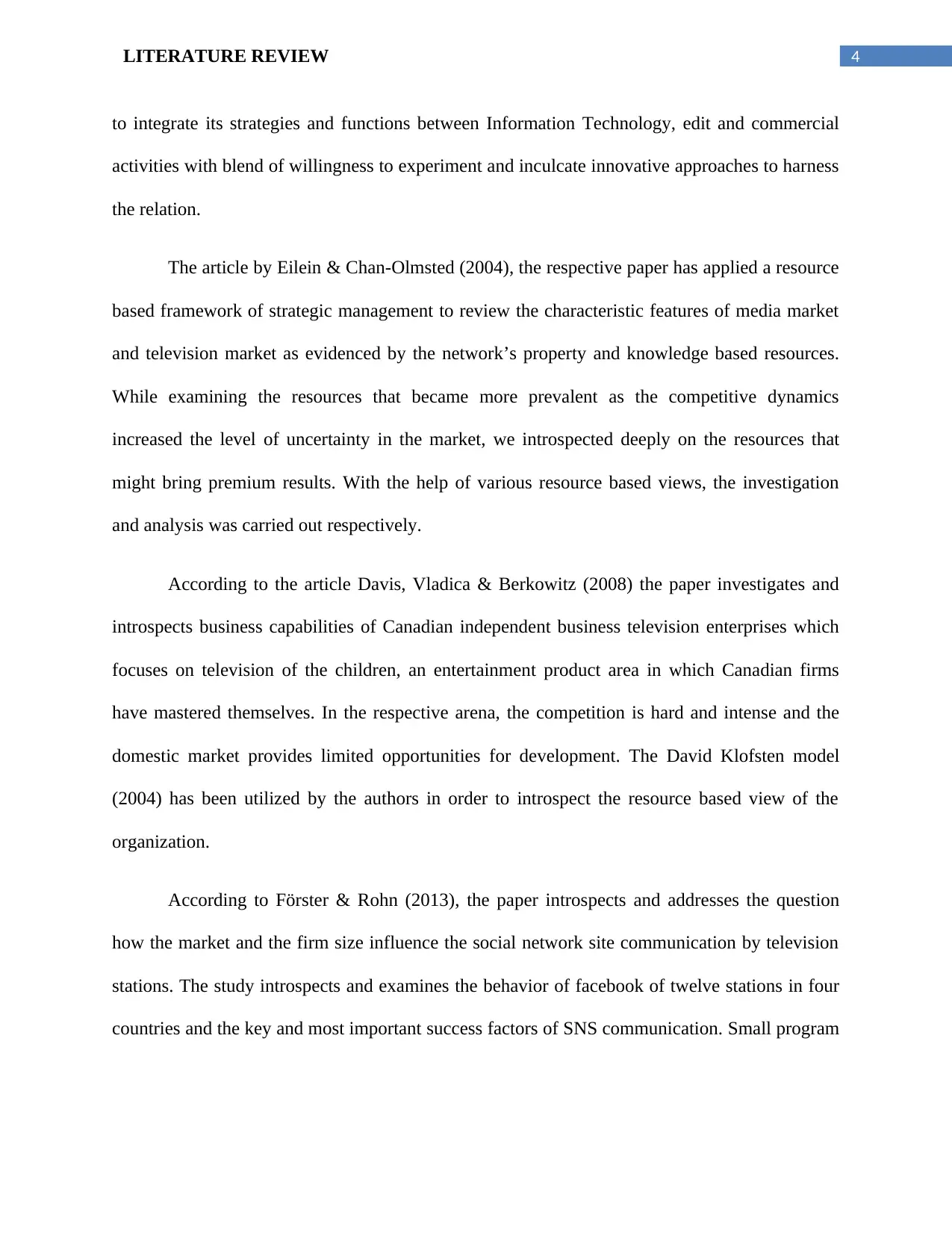
4LITERATURE REVIEW
to integrate its strategies and functions between Information Technology, edit and commercial
activities with blend of willingness to experiment and inculcate innovative approaches to harness
the relation.
The article by Eilein & Chan-Olmsted (2004), the respective paper has applied a resource
based framework of strategic management to review the characteristic features of media market
and television market as evidenced by the network’s property and knowledge based resources.
While examining the resources that became more prevalent as the competitive dynamics
increased the level of uncertainty in the market, we introspected deeply on the resources that
might bring premium results. With the help of various resource based views, the investigation
and analysis was carried out respectively.
According to the article Davis, Vladica & Berkowitz (2008) the paper investigates and
introspects business capabilities of Canadian independent business television enterprises which
focuses on television of the children, an entertainment product area in which Canadian firms
have mastered themselves. In the respective arena, the competition is hard and intense and the
domestic market provides limited opportunities for development. The David Klofsten model
(2004) has been utilized by the authors in order to introspect the resource based view of the
organization.
According to Förster & Rohn (2013), the paper introspects and addresses the question
how the market and the firm size influence the social network site communication by television
stations. The study introspects and examines the behavior of facebook of twelve stations in four
countries and the key and most important success factors of SNS communication. Small program
to integrate its strategies and functions between Information Technology, edit and commercial
activities with blend of willingness to experiment and inculcate innovative approaches to harness
the relation.
The article by Eilein & Chan-Olmsted (2004), the respective paper has applied a resource
based framework of strategic management to review the characteristic features of media market
and television market as evidenced by the network’s property and knowledge based resources.
While examining the resources that became more prevalent as the competitive dynamics
increased the level of uncertainty in the market, we introspected deeply on the resources that
might bring premium results. With the help of various resource based views, the investigation
and analysis was carried out respectively.
According to the article Davis, Vladica & Berkowitz (2008) the paper investigates and
introspects business capabilities of Canadian independent business television enterprises which
focuses on television of the children, an entertainment product area in which Canadian firms
have mastered themselves. In the respective arena, the competition is hard and intense and the
domestic market provides limited opportunities for development. The David Klofsten model
(2004) has been utilized by the authors in order to introspect the resource based view of the
organization.
According to Förster & Rohn (2013), the paper introspects and addresses the question
how the market and the firm size influence the social network site communication by television
stations. The study introspects and examines the behavior of facebook of twelve stations in four
countries and the key and most important success factors of SNS communication. Small program
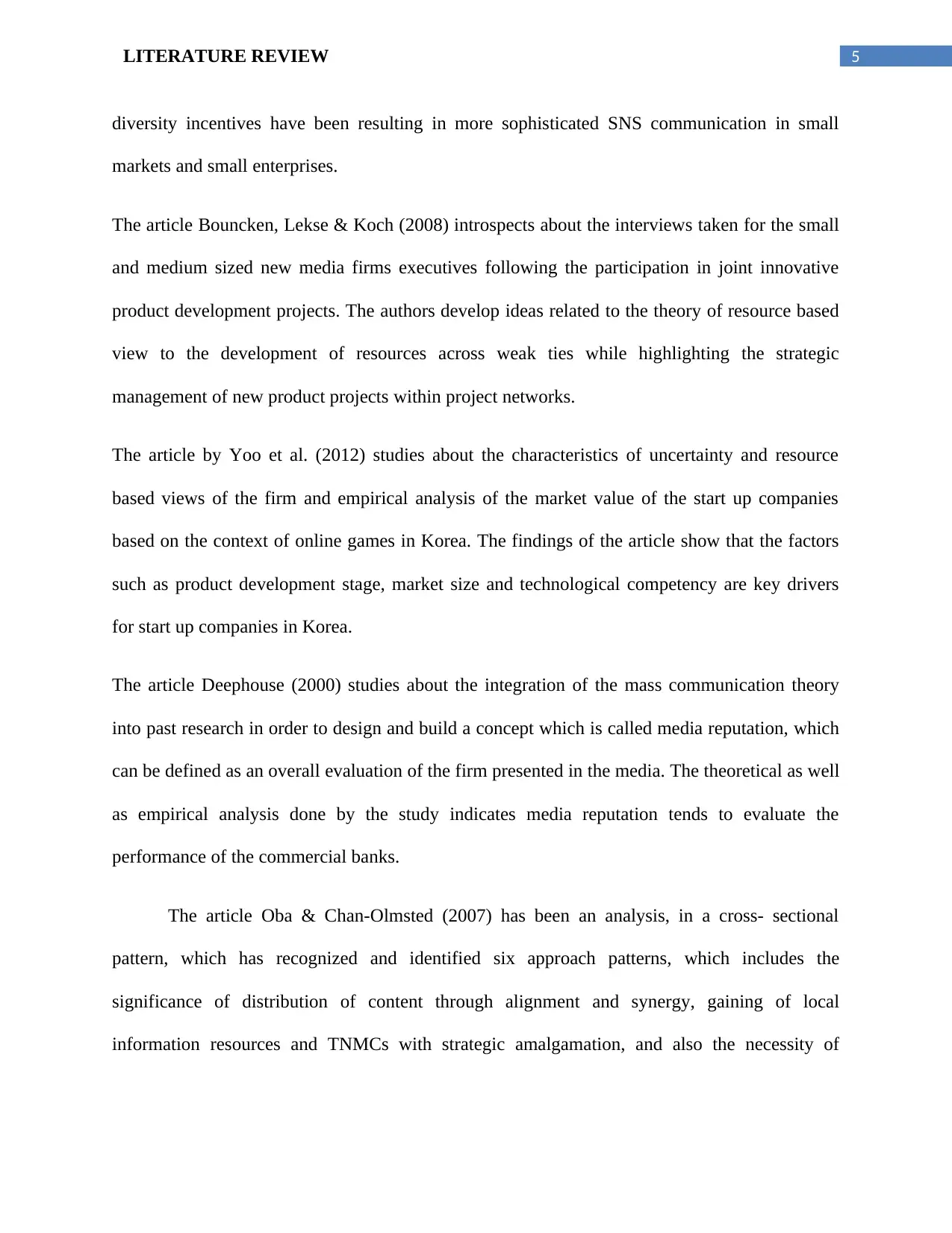
5LITERATURE REVIEW
diversity incentives have been resulting in more sophisticated SNS communication in small
markets and small enterprises.
The article Bouncken, Lekse & Koch (2008) introspects about the interviews taken for the small
and medium sized new media firms executives following the participation in joint innovative
product development projects. The authors develop ideas related to the theory of resource based
view to the development of resources across weak ties while highlighting the strategic
management of new product projects within project networks.
The article by Yoo et al. (2012) studies about the characteristics of uncertainty and resource
based views of the firm and empirical analysis of the market value of the start up companies
based on the context of online games in Korea. The findings of the article show that the factors
such as product development stage, market size and technological competency are key drivers
for start up companies in Korea.
The article Deephouse (2000) studies about the integration of the mass communication theory
into past research in order to design and build a concept which is called media reputation, which
can be defined as an overall evaluation of the firm presented in the media. The theoretical as well
as empirical analysis done by the study indicates media reputation tends to evaluate the
performance of the commercial banks.
The article Oba & Chan-Olmsted (2007) has been an analysis, in a cross- sectional
pattern, which has recognized and identified six approach patterns, which includes the
significance of distribution of content through alignment and synergy, gaining of local
information resources and TNMCs with strategic amalgamation, and also the necessity of
diversity incentives have been resulting in more sophisticated SNS communication in small
markets and small enterprises.
The article Bouncken, Lekse & Koch (2008) introspects about the interviews taken for the small
and medium sized new media firms executives following the participation in joint innovative
product development projects. The authors develop ideas related to the theory of resource based
view to the development of resources across weak ties while highlighting the strategic
management of new product projects within project networks.
The article by Yoo et al. (2012) studies about the characteristics of uncertainty and resource
based views of the firm and empirical analysis of the market value of the start up companies
based on the context of online games in Korea. The findings of the article show that the factors
such as product development stage, market size and technological competency are key drivers
for start up companies in Korea.
The article Deephouse (2000) studies about the integration of the mass communication theory
into past research in order to design and build a concept which is called media reputation, which
can be defined as an overall evaluation of the firm presented in the media. The theoretical as well
as empirical analysis done by the study indicates media reputation tends to evaluate the
performance of the commercial banks.
The article Oba & Chan-Olmsted (2007) has been an analysis, in a cross- sectional
pattern, which has recognized and identified six approach patterns, which includes the
significance of distribution of content through alignment and synergy, gaining of local
information resources and TNMCs with strategic amalgamation, and also the necessity of
⊘ This is a preview!⊘
Do you want full access?
Subscribe today to unlock all pages.

Trusted by 1+ million students worldwide
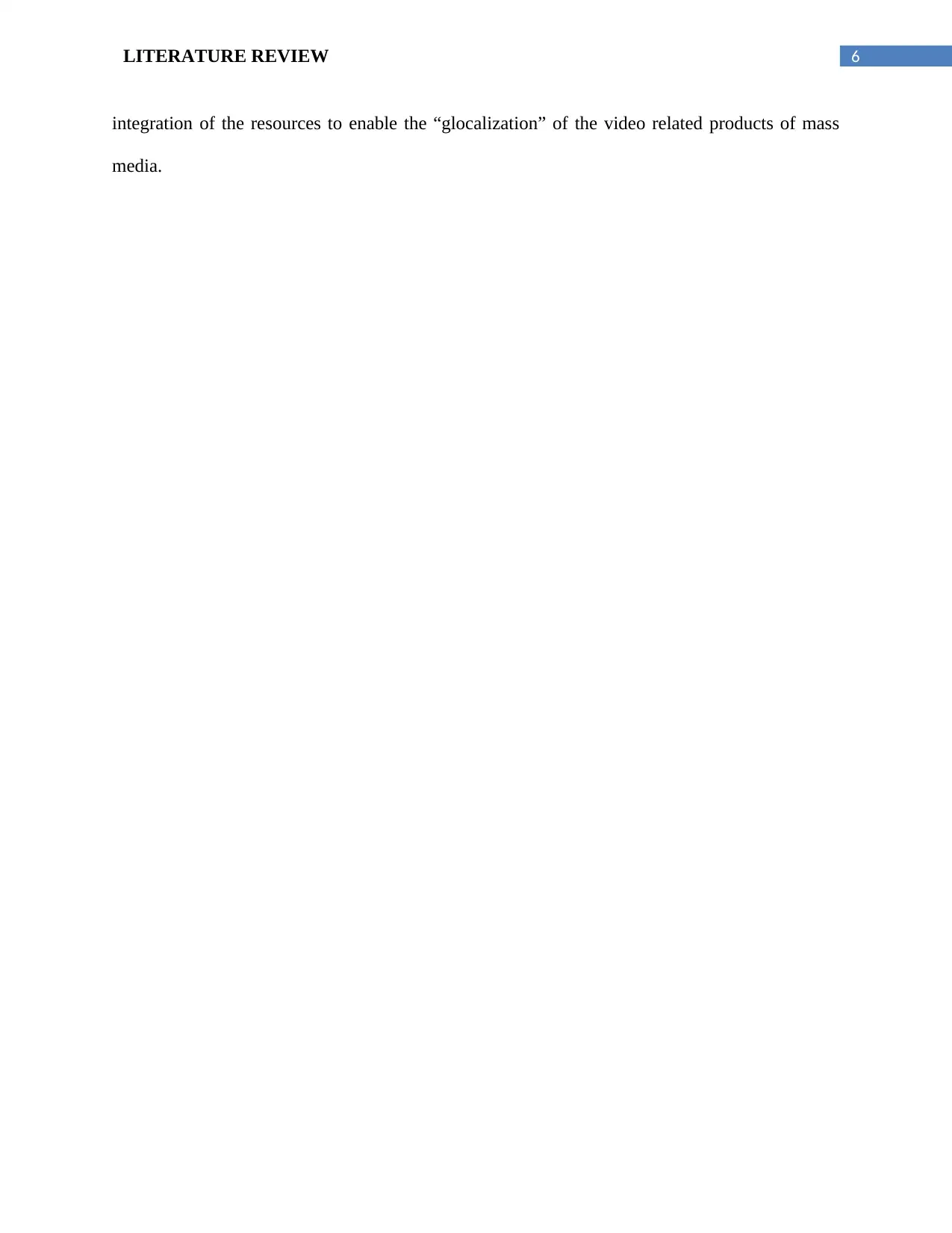
6LITERATURE REVIEW
integration of the resources to enable the “glocalization” of the video related products of mass
media.
integration of the resources to enable the “glocalization” of the video related products of mass
media.
Paraphrase This Document
Need a fresh take? Get an instant paraphrase of this document with our AI Paraphraser
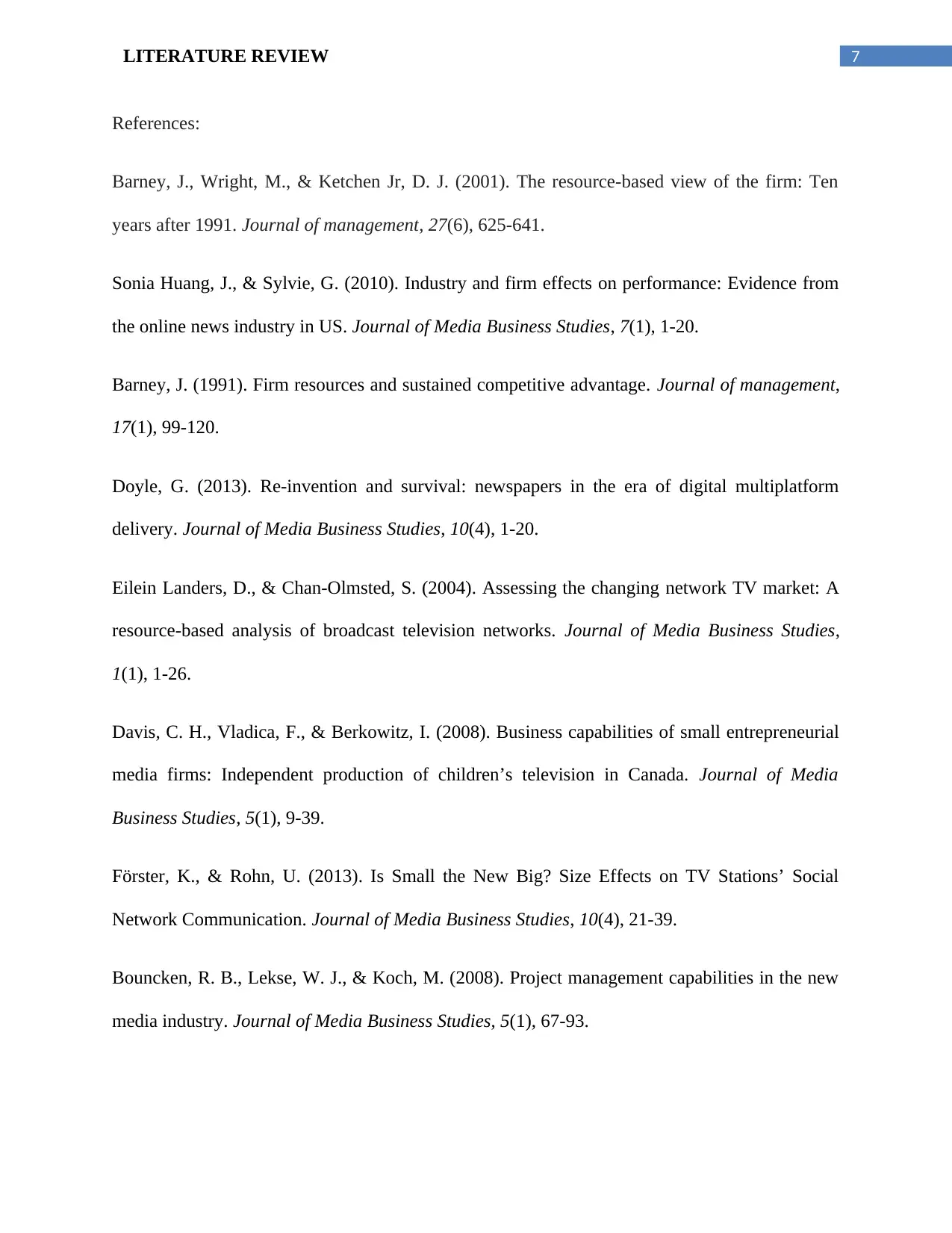
7LITERATURE REVIEW
References:
Barney, J., Wright, M., & Ketchen Jr, D. J. (2001). The resource-based view of the firm: Ten
years after 1991. Journal of management, 27(6), 625-641.
Sonia Huang, J., & Sylvie, G. (2010). Industry and firm effects on performance: Evidence from
the online news industry in US. Journal of Media Business Studies, 7(1), 1-20.
Barney, J. (1991). Firm resources and sustained competitive advantage. Journal of management,
17(1), 99-120.
Doyle, G. (2013). Re-invention and survival: newspapers in the era of digital multiplatform
delivery. Journal of Media Business Studies, 10(4), 1-20.
Eilein Landers, D., & Chan-Olmsted, S. (2004). Assessing the changing network TV market: A
resource-based analysis of broadcast television networks. Journal of Media Business Studies,
1(1), 1-26.
Davis, C. H., Vladica, F., & Berkowitz, I. (2008). Business capabilities of small entrepreneurial
media firms: Independent production of children’s television in Canada. Journal of Media
Business Studies, 5(1), 9-39.
Förster, K., & Rohn, U. (2013). Is Small the New Big? Size Effects on TV Stations’ Social
Network Communication. Journal of Media Business Studies, 10(4), 21-39.
Bouncken, R. B., Lekse, W. J., & Koch, M. (2008). Project management capabilities in the new
media industry. Journal of Media Business Studies, 5(1), 67-93.
References:
Barney, J., Wright, M., & Ketchen Jr, D. J. (2001). The resource-based view of the firm: Ten
years after 1991. Journal of management, 27(6), 625-641.
Sonia Huang, J., & Sylvie, G. (2010). Industry and firm effects on performance: Evidence from
the online news industry in US. Journal of Media Business Studies, 7(1), 1-20.
Barney, J. (1991). Firm resources and sustained competitive advantage. Journal of management,
17(1), 99-120.
Doyle, G. (2013). Re-invention and survival: newspapers in the era of digital multiplatform
delivery. Journal of Media Business Studies, 10(4), 1-20.
Eilein Landers, D., & Chan-Olmsted, S. (2004). Assessing the changing network TV market: A
resource-based analysis of broadcast television networks. Journal of Media Business Studies,
1(1), 1-26.
Davis, C. H., Vladica, F., & Berkowitz, I. (2008). Business capabilities of small entrepreneurial
media firms: Independent production of children’s television in Canada. Journal of Media
Business Studies, 5(1), 9-39.
Förster, K., & Rohn, U. (2013). Is Small the New Big? Size Effects on TV Stations’ Social
Network Communication. Journal of Media Business Studies, 10(4), 21-39.
Bouncken, R. B., Lekse, W. J., & Koch, M. (2008). Project management capabilities in the new
media industry. Journal of Media Business Studies, 5(1), 67-93.
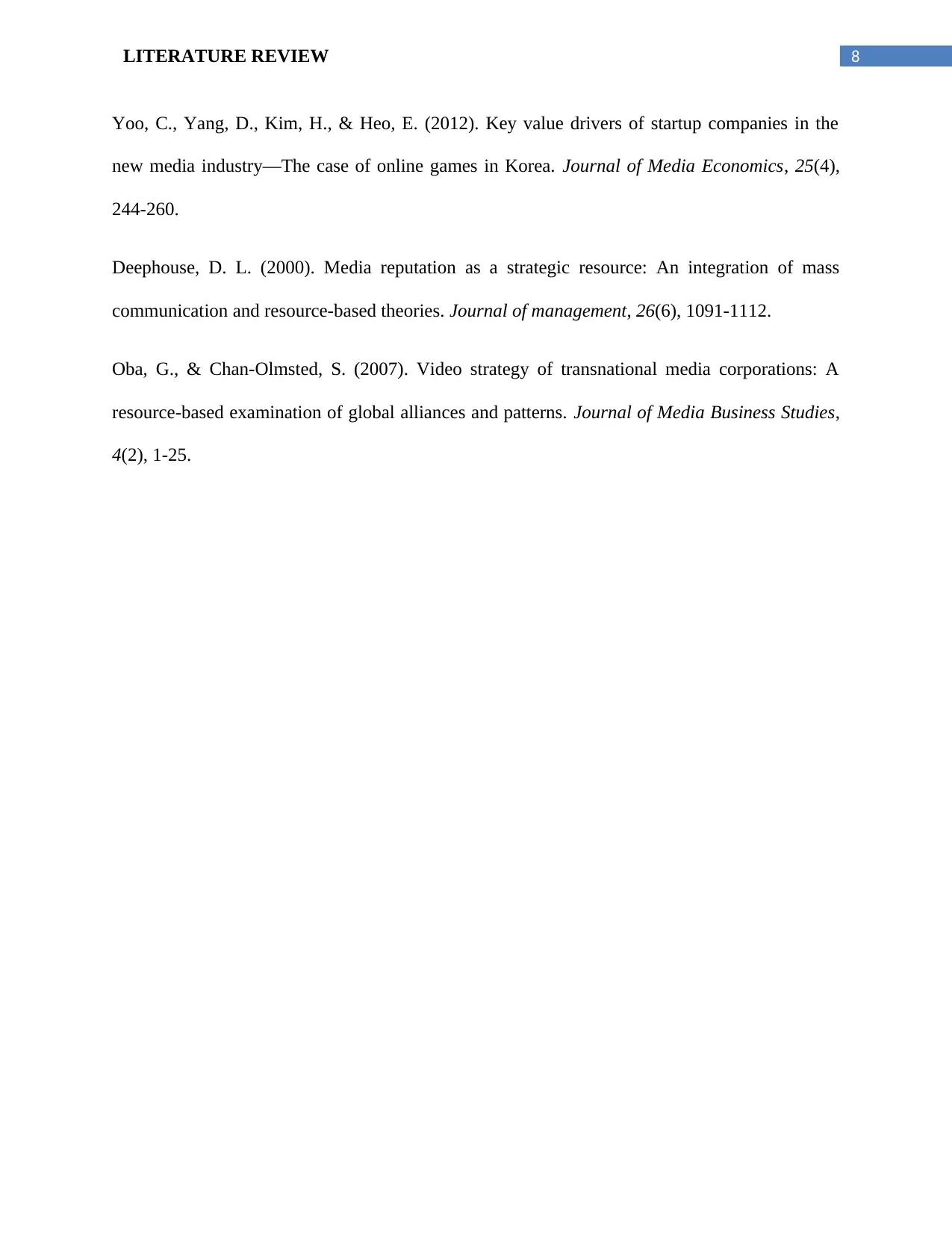
8LITERATURE REVIEW
Yoo, C., Yang, D., Kim, H., & Heo, E. (2012). Key value drivers of startup companies in the
new media industry—The case of online games in Korea. Journal of Media Economics, 25(4),
244-260.
Deephouse, D. L. (2000). Media reputation as a strategic resource: An integration of mass
communication and resource-based theories. Journal of management, 26(6), 1091-1112.
Oba, G., & Chan-Olmsted, S. (2007). Video strategy of transnational media corporations: A
resource-based examination of global alliances and patterns. Journal of Media Business Studies,
4(2), 1-25.
Yoo, C., Yang, D., Kim, H., & Heo, E. (2012). Key value drivers of startup companies in the
new media industry—The case of online games in Korea. Journal of Media Economics, 25(4),
244-260.
Deephouse, D. L. (2000). Media reputation as a strategic resource: An integration of mass
communication and resource-based theories. Journal of management, 26(6), 1091-1112.
Oba, G., & Chan-Olmsted, S. (2007). Video strategy of transnational media corporations: A
resource-based examination of global alliances and patterns. Journal of Media Business Studies,
4(2), 1-25.
⊘ This is a preview!⊘
Do you want full access?
Subscribe today to unlock all pages.

Trusted by 1+ million students worldwide
1 out of 9
Related Documents
Your All-in-One AI-Powered Toolkit for Academic Success.
+13062052269
info@desklib.com
Available 24*7 on WhatsApp / Email
![[object Object]](/_next/static/media/star-bottom.7253800d.svg)
Unlock your academic potential
Copyright © 2020–2025 A2Z Services. All Rights Reserved. Developed and managed by ZUCOL.





